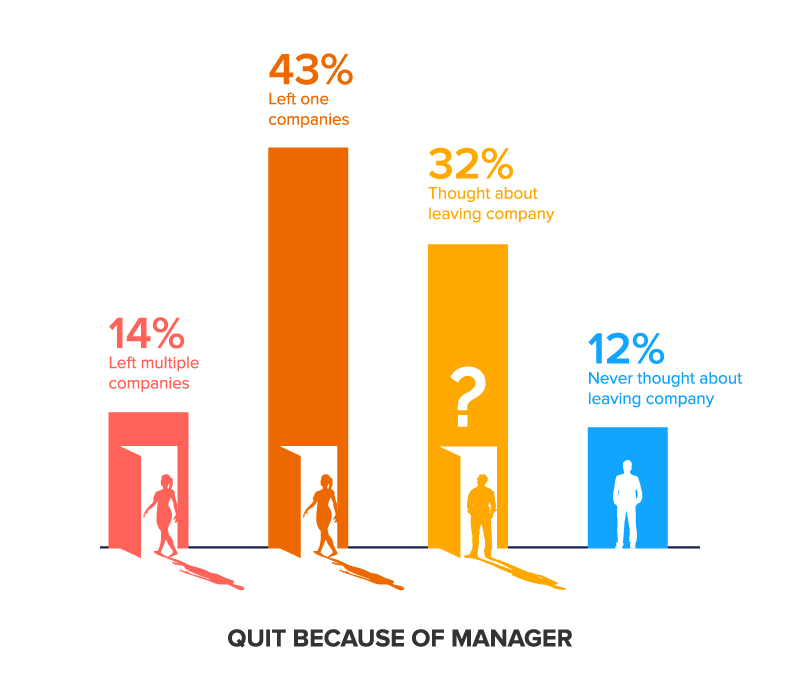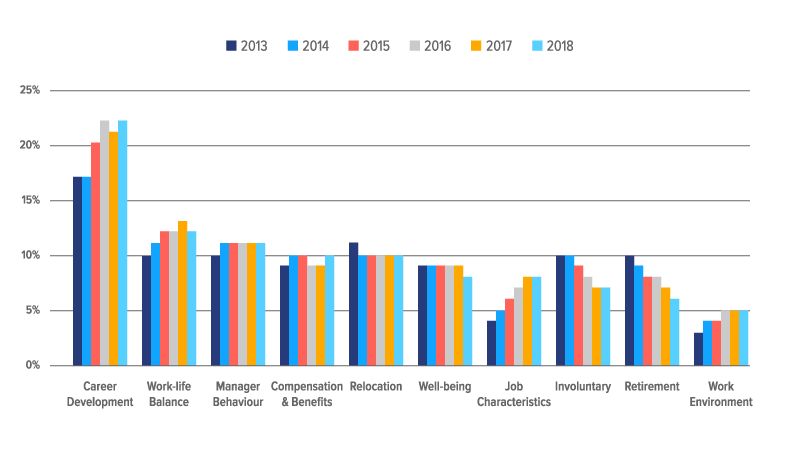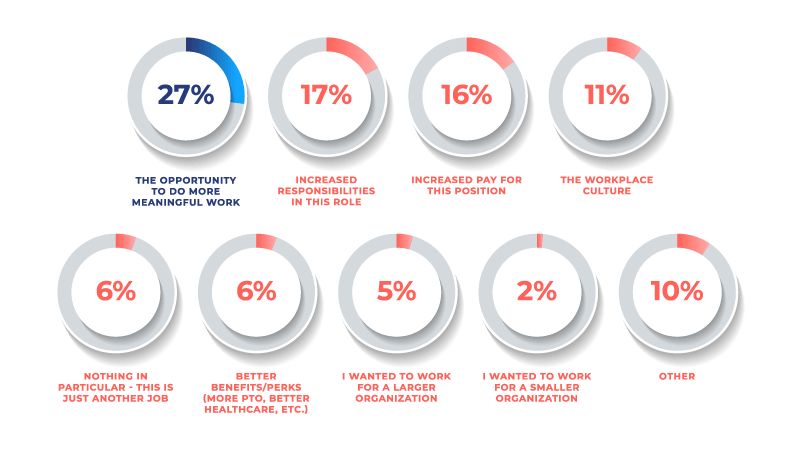Employee Turnover Ratio: Reasons Good Employees Quit Their Jobs

Table of Contents
Some key characteristics that many companies have and which make them believe that they’re different are the mission, business model, and product or service. Of course, establishing such a business and running it successfully is a daunting task and is fraught with challenges. However, when observed deeply, as the diversification of the organizations continues, the opportunities for workplace problems are witnessed to be intensifying.
Despite the various differences in strategies and execution, there are a few most common yet too tricky problems that affect the business exposed in unexpected ways. Among the many such issues, employee turnover is gradually increasing in the organizations and posing a dire circumstance, be it concerning the organization’s incurred cost of employee replacement or productivity.
In this article, let’s try to understand the employee turnover concept in detail and what causes the turnover and its impact on the business.
What Does Employee Turnover Mean?
During a specified time, the number of employees who leave an organization is called employee turnover. In other words, the loss of talent, typically for one year in the workforce, is defined as employee turnover. The loss may include the employee’s departure due to resignations, terminations, layoffs, transfers, retirements, or even death.

Employee Turnover Ratio
The figure that gives the organization an idea of how well the employee retention strategies are working, is the employee turnover ratio. This ratio reflects on the number of employees who have left your organization in a given period of time. However, it typically does not include the employees who have been transferred, promoted, or retired. Therefore, the lower the turnover ratio, the better it is for any company.
The ultimate purpose of calculating the employee turnover rate is to predict the impact of the loss of employees on productivity, customer service, as well as morale.
Please select from below options to help us improve our content:
What Are The Different Kinds Of Employee Turn Over?
Basically, employee turnover can be categorized into four types. They are as follows:
Voluntary Turnover
A situation wherein an employee decides to leave the organization on his own, maybe for a better career opportunity, is considered a voluntary turnover. According to a recent survey, voluntary turnover is likely to rise by 20% towards the end of 2024.
Involuntary Turnover
A situation wherein the organization’s management decides to terminate the employee (either for unproductivity or for misbehaving) is called an involuntary turnover.
Desirable Turnover
The turnover becomes desirable when an employee leaves the organization is nearly just an expense. In that case, a replacement could be a better option, paving the way for an efficient employee.
Non- Desirable Turnover
When a ‘good’ employee, who is productive, efficient, committed, and dedicated, leaves the organization, it is considered as a non-desirable turnover for the company.
However, the type of turnover the organization faces is comparatively irrelevant. But then, the turnover by itself or the employee’s absence will definitely take a toll on the organization’s overall productivity.

Is It Crucial To Measure Your Organization’s Turnover Rate?
Measuring employee turnover gives the organization the data and insights to understand its hiring practices and an opportunity to fill the necessary gaps that the company is unaware of. Apart from this, with the measurement of staff turnover, one can easily understand the organization’s workplace culture, policies, policies, compensation practices, procedures, etc.
In a way, the turnover calculation acts as the window in knowing the organization’s employee experience and average tenure. Above all, the awareness of the employee turnover ratio, causes, and the ways to overcome them will drastically cut down the costs that are unnecessarily spent by the organization on the following aspects-
- Recruitment
- Training (Online course software can help with this)
- Onboarding
- Replacement hiring
- Benefits
Hence, it is time for the companies to identify the causes and understand the importance of a desirable call to action to ensure its progress through employee retention.
How To Analyze The Organization’s Turnover Ratio?
The analysis of the employee turnover ratio in an organization can be understood better if the three following aspects are taken into proper consideration.
Who is Leaving?
The companies must identify and recognize which employees are leaving. Then, an analysis is to be undertaken to determine if high-performing or low-performing employees are exiting the organization. Once the companies are aware of this, necessary remedial actions can be determined according to the situation, either to retain the employees or let them go.
When Are They Leaving?
To understand the employee’s churn, identifying the time in which the employee leaves is crucial. For example, if the employee leaves within a few days of joining, it may be understood that the organization’s recruitment software or the job descriptions are to be re-evaluated. On the other hand, if it’s the employee leaving the organization despite working for many years, it could be due to the lack of employee engagement, absence of benefits, unclear career path, etc. This realization can help the organization reform and update the policies or refurbish the people’s processes.
Why Are They Leaving?
To identify and understand the reason for employee exit and its statistics, it is better to conduct a formal exit interview. Because there may be several reasons for the employee’s choice of leaving the organization, and it may differ from person to person. However, everything cannot be fixed overnight, but it may help the organizations start altering specific essential criteria.

The Critical Reasons For Good Employees To Quit Their Jobs
As discussed earlier, there are several reasons for the employees to quit their current job voluntarily. However, a study has revealed common yet most undeniable causes for employee turnover. The following are a few reasons that are at the top list. Let’s try to discuss them one by one.
Lack Of Manager’s Empathy
Have you heard of the saying, ‘Employees leave the managers and not the company?’ Believe it or not, workplace empathy is the priority and is supported by over 90% of employees. The situation is so because the employees feel that the managers lack empathy, which leads to the management’s mishappenings. For example, consider the image below, which shows the influence of the manager’s behavior on the employee’s choice of turnover.

Empathy is a crucial requisite for leaders, especially for managers who are in charge of a team consisting of employees. The managers are expected to look at their subordinates as ‘people’ and just as employees. By doing so, the employees would find themselves engaged and surely wouldn’t hesitate to go the extra mile. Therefore, in short, if the organization is looking for employee retention, the positive role and acceptable behavior of the managers play a significant role.
Lack Of New Opportunities
Growth and development are always a concern of the organization. And so are the needs of the employees. It is observed that the employees also look for new and competitive opportunities to keep themselves engaged. Today’s employees have a lot of potential in accomplishing the tasks and how they do them. Isn’t it an advantage for the organization too? Therefore, the more challenging the tasks are assigned to them, the more do they feel valued by the organization. Unlike the employees of earlier generations, many employees today are not just looking for a job to earn money or to keep themselves occupied. But then the motive is to build their career in what they are willing to do. Hence, if they don’t find a way to achieve this motive in your organization, it’s evident that they quit.
Burnout
The WHO (World Health Organization) has defined ‘Occupational Burnout” as a syndrome that is caused due to work-related stress. The symptoms can be characterized by feelings of energy exhaustion or depletion, increased mental stress resulting in the cognitive distancing from one’s job, feelings of negativism, and a drastic reduction in the professional efficacy. Especially in this competitive environment of business, employees are always expected to be at work. And because of this, they find themselves taking up extra projects, working overtime, and making and answering the calls off the clock. This behavior of the employees might seem like good characteristics of a hard-working and committed workforce. But then, in the longer run, it is likely to lead the employee to burnout and negatively impact the organization, leading to low productivity and increased absenteeism.
Employee Disengagement
The focus on the employees’ engagement has been observed to be steadily increasing in the last 15 years, as its importance in the workplace and its influence on the businesses has gradually been understood by the employers. More than 69% of the employees are less likely to seek a new job opportunity elsewhere if they are genuinely engaged with the organization. Similarly, the organizations must be aware that even if they assume that the employees are engaged, there are still about 51% of the employees who remain in the so-called engagement purgatory. These are the ones, who generally may be satisfied, but connected to their work and the workplace neither cognitively nor emotionally. This kind of attitude towards work may lead to a situation where the employees almost regularly show up to work. Still, then they only do the minimum work required and will instantly leave or quit your company even for a slightly better offer.
Lack Of Technological Updation
Often, the companies overlook the fact that today’s almost 75% of the employees are Millennial workers. Their demands, attitude towards work, and approach are all very different from earlier. Especially when it comes to technology, it’s there at most demand concerning efficiency, accuracy, speed of the task, and overall independence in many ways. For instance, preparing a month-end or year-end balance sheet, pay or salary slip, etc., is far gone with all the calculations manually. And imagine an employee needs their payslip. He has to depend on the HR manager or the concerned person until he is free to do the needful. But then, the growth of technology and the various software available, including employee payroll management software, reduces the dependency on the one hand, enhancing productivity and efficiency. Similarly, if the technology and its tools are taken advantage of and if its utilization is updated and implemented, it contributes to employee engagement and productivity. Technology plays a significant role in enhancing the already potential employees to put in minimal efforts for the most appropriate outcome. Thus, if you are equipped with the proper technology and its implementation, it becomes one way of helping you to keep your employees from quitting your organization.
Undesired Work-Life Balance
It was once said that ‘When your employees don’t sleep, eat crap, don’t exercise, and are living off adrenaline for too long, their performance suffers. And because of this, your organizational decisions suffer. And on the whole, your company suffers’. Balancing the professional and personal life of the employee is essential. If your workforce is bogged down with work, they will be dissatisfied and unhappy. Motivate and encourage your employees to take short breaks, and make sure their workload is manageable. Apart from this, also see to that they aren’t forced to start early or stay late all the time. Social outings can be practiced along with work because it’s important to promote a good working environment and positivity between colleagues. Thus, providing a platform for the employees to balance personal and professional life is an essential criterion to ensure ensure employees retention. This effort from the employers towards the employees shows that the workforce is cared for and fills the employees with a lot of satisfaction. Happy and satisfied employees mean they are engaged with the organization. Once they are engaged, obviously, they wouldn’t want to leave the organization.
Uninspiring Company Culture
The organization’s culture also plays a major role in influencing the employees’ decision to stay or quit in an organization. Research shows that about 47% of the employees are ready to quit the company because of the lack of a positive environment in the organization, despite the many perks and rewards offered. It is quite understandable that there are a lot of stresses and strains involved in running a business, but then, taking out such frustrations on the employees is not the right thing to do. In fact, the employees are the ones who are trying to help you, and it would be better if you could meet them at least halfway through. And a toxic environment is obvious to cause mental stress to the employees as well as their outlook on their jobs. Continuous stress and frustration may lead to a situation where the employees themselves start questioning their job security and worth. Instead of encouraging the employees, if the managers’ approach is negative, then even the employees might shift their focus from ‘how they can do the job’ to ‘how not to do a bad job’, which will obviously cause mistakes and disengagement. The other undesirable practices in the company can be partiality in treating the employees differently, gossip and groupies, etc. This can all lead to the disengagement of the employees and burnouts and good employees quitting the organization. Overall, the company’s culture shouldn’t be that which makes the employee feel dreaded as soon as they wake up about the environment that they have to spend the next 8-9 hours of their lives.
Lack Of Respect, Appreciation, And Recognition
As discussed earlier in the article, there is a lot of difference and shift in the approach towards work from the employees. It is not that all the employees are looking for only monetary benefits from the companies. The competitiveness is not just among the businesses but also among the organization’s workforce. Therefore, the employees expect more performance appreciation and recognition for their work than money-based benefits. When an employee is appreciated even for a small contribution of his or in the better way that he has done, it gives him a lot of satisfaction and contentment. This also makes him feel motivated and contribute even more. Unfortunately, it is observed that the employees’ success is least recognized, but the mistakes are highlighted the most. This situation has led to no space for the employee’s growth in the workplace. Added to this, they start feeling undervalued and unutilized. Hence, the lack of recognition, respect, and appreciation is gradually becoming one of the crucial reasons for the employees quitting the company.
Lack of flexible work arrangements
Among the various shifts in the work attitudes, one of the recent concerns and demands of the employees is the availability of flexible or remote working. Especially after the lockdown due to Covid-19, which led to one of the most significant experiments of working from home, the employees are more comfortable and productive. Although the experience was sudden and unplanned, it was well accepted and embraced by almost 70% of the overall employees. Despite the health crisis gradually subsiding, and things are getting back to normal but slightly different from what was before, the preference among the employees is still remote working. Statistics reveal that the employees are ready to quit and shift to the companies that provide them with more flexible working arrangements. According to the statistics, 37% of the employees are willing to leave their current position for a job that allows them to work remotely for atleast a part of their work period. And about 82% of the employees are found to be more loyal and committed to the current employer who is willing to offer more flexibility in working.
Personal Life Of The Employee
The causes that were discussed above were all related to the company, in which the companies have or could have played an influential role in the employees’ choice of quitting. However, certain aspects are inevitable, and the organization has no stand or say, but just got to deal and accept the choice. One such influential aspect is the personal life of the employee. It may include relocating himself and the family geographically, career development, and many more, which may or may not be agreed upon by the company.
Employees quit the organizations for different reasons, be it voluntary or involuntary. However, the employee turnover is not considered reasonable or suitable for the organization’s overall growth. It indeed is a painful process of losing some of the best talents of your company. On the whole, the causes and the percentage of the employees quitting the organization can be pictorially observed in the following image. Have a look for a better understanding.

Calculation Of Employee Turnover Ratio
As of now, we have already tried to understand the effect of employee turnover on the company and the need to be aware of it. Now let’s’ attempt to understand how to calculate the turnover ratio.
Generally, organizations calculate the ratio based on two specific time periods. Namely-
- Monthly Employee Turnover Ratio
- Yearly Employee Turnover Ratio
Let’s see the calculation.
Monthly Employee Turnover Ratio
In order to calculate the ratio of monthly turnover, we need 3 variables. They are:
- No. of active employees in the month’s beginning
- No. of active employees in the month’s end
- No. of employees who left during the month
Once defined the variables, you need to find the average number of the employees using the following formula-
Average number of employees = employees in the beginning + employees at the end / 2
When the average employees are calculated, you can find the monthly employee turnover ratio using the following formula-
Monthly Employee Turnover Ratio = Employees left / Average Employees x 100
Yearly Employee Turnover Ratio
However, many organizations prefer calculating employee turnover on an annual basis. The variables needed are-
- No. of active employees in the year’s beginning
- No. of active employees in the year’s end
- No. of employees who left during the year
The formula to calculate the yearly employee turnover ratio is-
Annual Turnover%=No. of employees left / (Beginning + Ending No. of employees) /2×100
For example: If you have 100 employees at the start of the year and 170 at the end of the year, and 7 employees left during that year, your annual turnover rate would be calculated as:
Annual Turnover Ratio = 7/(100+170)/2 X100 7/270/2 X 100 7/135 X100 0.05 X 100 5%
Therefore, according to the calculation, the annual employee turnover ratio is 5%.

How To Reduce Employee Turnover?
When we talk about employee turnover in an organization, practically, turnover by itself is inevitable. However, organizations can make an effort to reduce it. But then, ‘HOW’ is always the concern. Here are a few tips that can be considered in terms of turnover reduction.
- Firstly, identify the right candidates
- Offer competitive compensation
- Recognize, appreciate, and reward the employees for their achievements
- Invest in their training and development
- Develop strategies to engage the employees
Employee Turnover Statistics
- For replacing an employee, the company has to suffer from the cost of about one-half or two times the worker’s salary.
- About 66% of the employees realize that the job they accepted is not a good fit for them.
- Nearly 87% of employers consider the necessity of improving employee retention for their company.
- Due to career development opportunities, nearly 72% of the employees change their job.
- About 28% of the employees pointed out bad culture as their primary reason for leaving the job in the first 90 days.
- 44% of the employees leave their job due to a lack of recognition and engagement in their organization.
What Do The Employees Look For?
As much as the organizations take the initiative to reduce the turnover ratio, there has always been a gap in trying to understand exactly what the employees need. At times it becomes so difficult to understand things from their perspective. Therefore, a survey reveals the following statistics, which is presented to you, hoping it would help the organizations.

Winding Up
There is a massive talent shortage, and the organizations are expected to give in a little to retain their top talent. Of course, it’s not necessary to be a billionaire to give luxurious perks. But then, what matters is the opportunity given to people to grow and evolve.
Therefore, identify the employees’ current needs and align the same with the organization’s policies and functioning to ensure your workforce’s retention for the company’s growth and progress.
Grow your business with factoHR today
Focus on the significant decision-making tasks, transfer all your common repetitive HR tasks to factoHR and see the things falling into their place.

© 2025 Copyright factoHR


